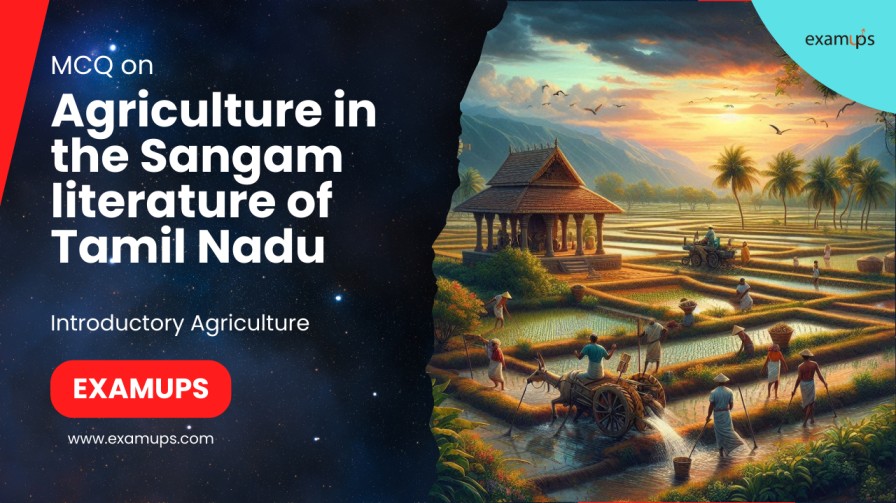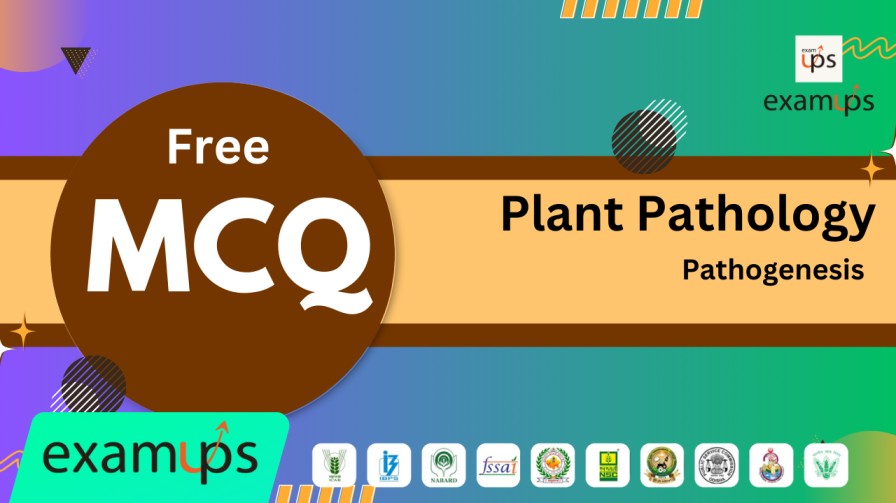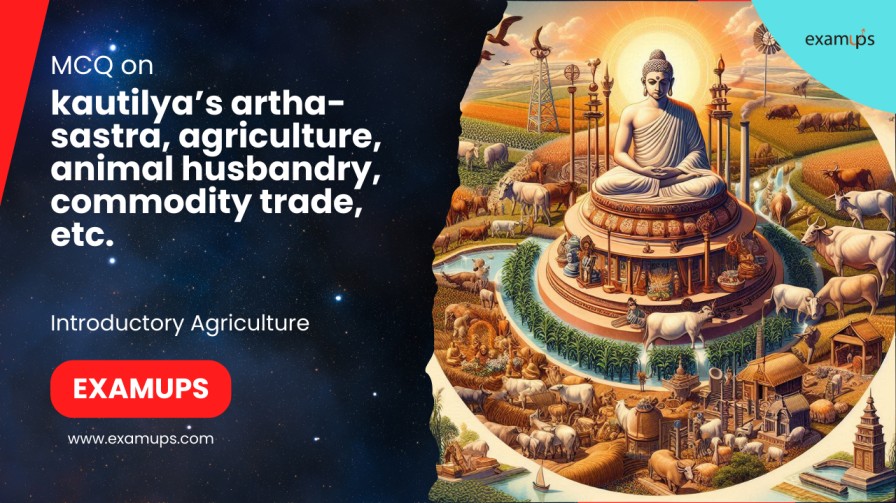MCQ on Agriculture in the Sangam literature of Tamil Nadu for ICAR-JEF, ICAR-SRF, ICAR-NET, IBPS-AFO/SO, Pre-PG, BHU Pre-PG, IFFCO-AGT, CCI, FCI, B.sc, M.sc, All Agriculture Competitive Exams.
1. Which period does the Sangam literature belong to?
a) 200 AD to 500 AD
b) 100 BC to 200 AD
c) 200 BC to 100 AD
d) 500 BC to 200 BC – **Answer: c) 200 BC to 100 AD** – Explanation: The Sangam literature belongs to the period between 200 BC to 100 AD.
2. What was the primary occupation of the population in the Tamil region during the Sangam period?
a) Trading
b) Agriculture
c) Fishing
d) Hunting – **Answer: b) Agriculture** – Explanation: The main profession of the population during the Sangam period was agriculture.
3. Which regions were included in the Tamil region during the Sangam period?
a) Tamil Nadu and Kerala
b) Tamil Nadu and Karnataka
c) Tamil Nadu, Kerala, and Andhra Pradesh
d) Tamil Nadu, Kerala, Karnataka, and Andhra Pradesh – **Answer: d) Tamil Nadu, Kerala, Karnataka, and Andhra Pradesh** – Explanation: The Tamil region during the Sangam period included Tamil Nadu, Kerala, Karnataka,
and parts of Andhra Pradesh.
4. Who is known as the “Tamil grandfather” for his efforts in collecting and publishing Sangam
literature?
a) Tholkappier
b) Thiruvalluvar
c) Swaminatha Iyer
d) Thirumalai Nayakkar – **Answer: c) Swaminatha Iyer** – Explanation: Swaminatha Iyer, popularly known as “Tamil grandfather,” collected and published
Sangam literature.
5. Which poem from the Sangam period provides descriptions of various agricultural aspects?
a) Thirukural
b) Tholkappiyam
c) Silappadikaram
d) Manimekalai – **Answer: b) Tholkappiyam** – Explanation: Tholkappiyam provides descriptions of various agricultural aspects during the
Sangam period.
6. How many groups were the lands classified into according to Tholkappiyam?
a) Three
b) Four
c) Five
d) Six – **Answer: b) Four** – Explanation: Land was classified into four groups: mullai, Kurinji, marudham, and neithal.
7. Which one of the following is not a classification of land according to Tholkappiyam?
a) Hills
b) Coastal areas
c) Rivers
d) Cultivable lands – **Answer: c) Rivers** – Explanation: Tholkappiyam classified land into hills, coastal areas, and cultivable lands, but not
rivers.
8. Who authored the poem Tholkappiyam?
a) Thiruvalluvar
b) Thirumalai Nayakkar
c) Tholkappier
d) Swaminatha Iyer – **Answer: c) Tholkappier** – Explanation: Tholkappier authored the poem Tholkappiyam.
9. What does Tholkappiyam give descriptions of?
a) Religious practices
b) Social hierarchy
c) Agricultural aspects
d) Political structure – **Answer: c) Agricultural aspects** – Explanation: Tholkappiyam provides descriptions of various agricultural aspects.
10. What material was used for writing manuscripts during the Sangam period?
a) Paper
b) Palmyra leaves
c) Papyrus
d) Animal skins
– **Answer: b) Palmyra leaves** – Explanation: Manuscripts during the Sangam period were written on palmyra leaves.
11. Which of the following crops were ratooned according to the text?
a) Rice
b) Millets
c) Sugarcane
d) Coconut – **Answer: c) Sugarcane** – Explanation: Sugarcane was one of the crops that were ratooned, as mentioned in the text.
12. How were plants considered according to the Sangam literature?
a) Inanimate objects
b) Non-living entities
c) Living beings with sensitivity
d) Mechanical structures – **Answer: c) Living beings with sensitivity** – Explanation: Plants were considered as living beings and endowed with sensitivity in the Sangam
literature.
13. Who considered agricultural development as their primary duty according to the text?
a) Merchants
b) Farmers
c) Kings
d) Priests – **Answer: c) Kings** – Explanation: Kings considered agricultural development as their primary duty, as stated in the
text.
14. What was considered the yardstick of prosperity of the country according to the text?
a) Population growth
b) Industrial development
c) Increased agricultural production
d) Foreign trade – **Answer: c) Increased agricultural production** – Explanation: Increased agricultural production was considered a yardstick of prosperity of the
country.
15. Who was responsible for raising the bunds of the river Cauvery, according to the text?
a) Farmers
b) Slaves from a conquered country
c) Priests
d) Kings – **Answer: b) Slaves from a conquered country** – Explanation: The king Karikal Cholan brought 1000 slaves from a conquered country to raise the
bunds of the river Cauvery.
16. What was used for ploughing according to the text?
a) Oxen
b) Horses
c) Buffaloes
d) Elephants – **Answer: c) Buffaloes** – Explanation: Buffaloes were used for ploughing, as mentioned in the text.
17. What was considered superior to shallow ploughing?
a) Deep ploughing
b) Surface ploughing
c) Vertical ploughing
d) Circular ploughing – **Answer: a) Deep ploughing** – Explanation: Deep ploughing was considered superior to shallow ploughing.
18. What was used for leveling paddy according to the text?
a) Wooden plough
b) Metal rake
c) Parambu
d) Hoe – **Answer: c) Parambu** – Explanation: A labour-saving tool called parambu was used for leveling paddy.
19. According to the text, when should irrigation be given?
a) Mid-day
b) Early morning or late evening
c) Afternoon
d) Night – **Answer: b) Early morning or late evening** – Explanation: Irrigation should be given either in the early morning or late evening, not during hot
mid-day.
20. What is considered a masterpiece of engineering even today according to the text?
a) Stone dam across the river Cauvery
b) Wooden bridge across the river Ganges
c) Irrigation canal in the Indus Valley
d) Aqueduct in Rome – **Answer: a) Stone dam across the river Cauvery** – Explanation: The stone dam constructed across the river Cauvery centuries ago is considered a
masterpiece of engineering even today.
21. What tools were used to lift water from wells, tanks, and rivers according to the text?
a) Hoe and shovel
b) Amiry, keilar, and yettam
c) Plough and rake
d) Scythe and sickle – **Answer: b) Amiry, keilar, and yettam** – Explanation: Tools such as amiry, keilar, and yettam were used to lift water from wells, tanks, and
rivers.
22. Which tools were used for scaring birds in millet fields?
a) Hoe and shovel
b) Scythe and sickle
c) Thattai and kavan
d) Plough and rake – **Answer: c) Thattai and kavan** – Explanation: Tools called thattai and kavan were used for scaring birds in millet fields.
23. What were used to catch wild boars in millet fields according to the text?
a) Traps
b) Dogs
c) Nets
d) Poison – **Answer: a) Traps** – Explanation: Traps were used to catch wild boars in millet fields.
24. What was the belief regarding the use of selected seed according to the text?
a) It would increase the yield.
b) It was believed to destroy the family if used as food grain.
c) It was considered a bad omen.
d) It would bring good luck. – **Answer: b) It was believed to destroy the family if used as food grain.** – Explanation: The selected seed was stored for sowing only and never used as food grain because it
was believed that such a diversion would destroy the family.
25. What crop was raised after rice to benefit the following rice crop?
a) Black gram (urd)
b) Wheat
c) Barley
d) Sorghum – **Answer: a) Black gram (urd)** – Explanation: Crop rotation was practiced by raising black gram (urd) after rice to benefit the
following rice crop.
26. What was used for threshing rice according to the text?
a) Hand
b) Buffalo
c) Elephant
d) Machine – **Answer: b) Buffalo** – Explanation: Threshing of rice was done by hand with the help of a buffalo.
27. How was chaff removed after threshing?
a) Burning
b) Hand winnowing
c) Machine separation
d) Animal trampling – **Answer: b) Hand winnowing** – Explanation: Hand winnowing was done to remove chaff after threshing.
28. What portion of the produce was paid as tax to the king?
a) One fourth
b) One third
c) One half
d) One sixth – **Answer: d) One sixth** – Explanation: One sixth of the produce was paid as tax to the king.
29. What were recommended agronomic practices even today based on scientific principles?
a) Crop rotation and mixed cropping
b) Threshing and winnowing
c) Irrigation and seed selection
d) Ploughing and transplanting – **Answer: a) Crop rotation and mixed cropping** – Explanation: Agronomic practices such as crop rotation and mixed cropping are recommended
even today based on scientific principles.
30. Who mainly attended to light agricultural work according to the text?
a) Men
b) Women
c) Children
d) Elderly – **Answer: b) Women** – Explanation: Operations requiring hard work were done by men while women attended to light
work such as transplanting, weeding, bird scaring, harvesting, and winnowing.
31. In which literary work is the story of Valli, daughter of a king, mentioned?
a) Silappadikaram
b) Thirukural
c) Kandapuranam
d) Tholkappiyam – **Answer: c) Kandapuranam**
– Explanation: The story of Valli, daughter of a king, is mentioned in Kandapuranam.
32. What was the method of exchange for products mentioned in the text?
a) Barter system
b) By bar code
c) By weight
d) By volume – **Answer: c) By weight** – Explanation: Products were exchanged by weight according to the text.
33. Where was the food grain bazaar located, as mentioned in the text?
a) Chennai
b) Kanyakumari
c) Madurai
d) Coimbatore – **Answer: c) Madurai** – Explanation: Madurai was the headquarters of Sangam poets and had a food grain bazaar where
various cereals, millets, and pulses were sold.
34. How many couplets does Thirukural consist of?
a) 500
b) 1000
c) 1330
d) 1500 – **Answer: c) 1330** – Explanation: Thirukural consists of 1330 couplets.
35. Under which chapter of Thirukural is agriculture discussed?
a) Love
b) Wealth
c) Politics
d) Ethics – **Answer: c) Politics** – Explanation: Thirukural devotes one topic (10 couplets) for agriculture under the chapter of
politics.
36. What is mentioned as the prime duty of a king according to Thirukural?
a) Ensuring justice
b) Ensuring agricultural production
c) Expanding territory
d) Protecting the treasury – **Answer: b) Ensuring agricultural production** – Explanation: Thirukural recognizes the prime duty of a king as ensuring agricultural production.
37. What historical event is cited to illustrate the importance of food security?
a) The French Revolution
b) The American Civil War
c) The Russian Revolution
d) The Industrial Revolution – **Answer: a) The French Revolution** – Explanation: The text cites the French Revolution as an example of the consequences of food
shortage leading to social unrest and political change.
38. What caused the potato shortage in Germany during World War I?
a) Excessive rain
b) Potato blight disease
c) Insect infestation
d) Crop failure – **Answer: b) Potato blight disease** – Explanation: The potato shortage in Germany during World War I was caused by the late blight
disease of potato.
39. What was affected due to the diversion of copper during World War I?
a) Grain production
b) Potato cultivation
c) Production of copper sulfate
d) Transportation infrastructure – **Answer: c) Production of copper sulfate** – Explanation: The diversion of copper affected the production of copper sulfate, which was crucial
for controlling potato blight.
40. What does the anecdote about the nail symbolize?
a) The importance of small things
b) The value of horses
c) The significance of preparedness
d) The impact of war on agriculture – **Answer: a) The importance of small things** – Explanation: The anecdote highlights the significance of small things and how they can lead to
larger consequences, emphasizing the importance of attention to detail.
41. What consequence is mentioned in the text due to the lack of soldiers?
a) Victory in war
b) Defeat in war
c) Peace negotiations
d) Military training – **Answer: b) Defeat in war** – Explanation: The phrase “For want of soldier, the war was lost” implies that the lack of soldiers
leads to defeat in war.
42. What is cited as a reason for the fall of several state governments in India?
a) Economic recession
b) Failure of public distribution system
c) Political corruption
d) Environmental disasters – **Answer: b) Failure of public distribution system** – Explanation: Several state governments in India have fallen due to the failure to ensure an
adequate supply of food grains through the public distribution system.
43. According to the text, what do industries spin around?
a) Technology
b) Agriculture
c) Commerce
d) Education – **Answer: b) Agriculture** – Explanation: The text suggests that all industries spin around agriculture.
44. Who is described as living an independent life according to the text?
a) Merchants
b) Farmers
c) Artisans
d) Soldiers – **Answer: b) Farmers** – Explanation: Farmers alone are described as living an independent life in the text.
45. What is emphasized as more important than plowing in the text?
a) Crop protection
b) Irrigation
c) Harvesting
d) Seed selection – **Answer: a) Crop protection** – Explanation: The text states that crop protection is more important than irrigation.
46. What methods of manuring were in vogue according to the text?
a) Green leaf manuring, chemical manuring, and sheep penning
b) Farmyard manure, chemical fertilizers, and composting
c) Green leaf manuring, farmyard manure, and sheep penning
d) Chemical fertilizers, composting, and vermicomposting – **Answer: c) Green leaf manuring, farmyard manure, and sheep penning** – Explanation: Green leaf manuring, farmyard manure, and sheep penning were in vogue for
manuring, although farmers were not aware that they supplied nitrogen to the crop.
47. What method of irrigation was followed for efficient water management?
a) Drip irrigation
b) Sprinkler irrigation
c) Flood irrigation
d) Bed method – **Answer: d) Bed method** – Explanation: The bed method was followed as an efficient method of water management
according to the text.
48. What analogy is drawn between farmers and kings in the text?
a) Farmers are like kings
b) Kings are like farmers
c) Farmers pull out weeds, kings eliminate rowdies
d) Kings pull out weeds, farmers eliminate rowdies- **Answer: c) Farmers pull out weeds with the root system, so the king should eliminate rowdies
from society** – Explanation: The text draws an analogy between farmers pulling out weeds with the root system
and kings eliminating rowdies from society.
49. What aspect of crop care is emphasized in the text?
a) Harvesting
b) Plowing
c) Weeding
d) Seed selection – **Answer: c) Weeding** – Explanation: The text emphasizes the importance of weeding in crop care.
50. What does the text suggest about the depth of agricultural knowledge possessed by ancestors?
a) They had limited knowledge
b) They had no knowledge
c) They had vast knowledge
d) They had theoretical knowledge – **Answer: c) They had vast knowledge** – Explanation: The text suggests that ancestors had vast agricultural knowledge, as evidenced by
their practices and understanding of concepts such as manuring and irrigation.










